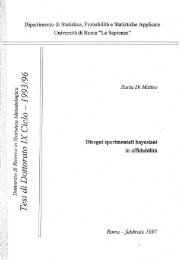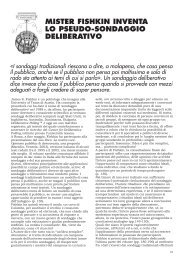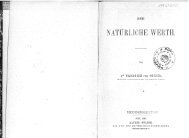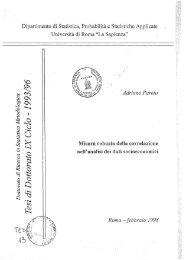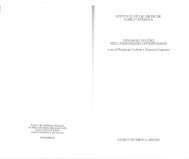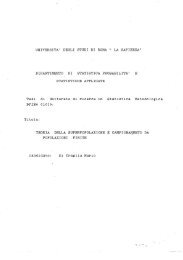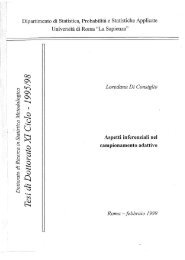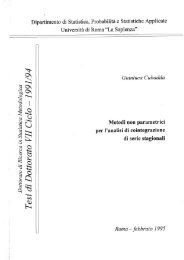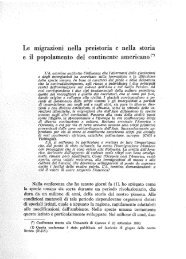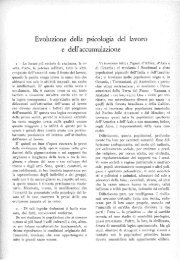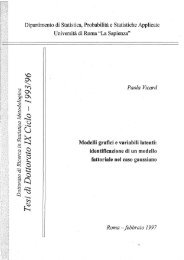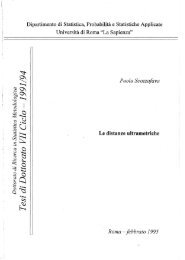Random Processes in Hyperbolic Spaces Hyperbolic Brownian ...
Random Processes in Hyperbolic Spaces Hyperbolic Brownian ...
Random Processes in Hyperbolic Spaces Hyperbolic Brownian ...
Create successful ePaper yourself
Turn your PDF publications into a flip-book with our unique Google optimized e-Paper software.
15 <strong>Hyperbolic</strong> Geometry<br />
S(0, 1) followed by the reflection <strong>in</strong> the sphere S(0, √ k). The transformations of the form<br />
φ(x) =<br />
ax + b<br />
cx + d<br />
where a, b, c, d are real and such that ad − bc = 0 are Möbius transformations. In fact φ(x) =<br />
φ4 ◦ φ3 ◦ φ2 ◦ φ1(x) where φ1(x) = x + d<br />
c is a translation, φ2(x) = 1<br />
x is an <strong>in</strong>version and a reflection<br />
with respect to the real axis, φ3(x) = − ad−bc<br />
c 2<br />
is a translation.<br />
(2.6)<br />
x is a magnification and a rotation and φ4(x) = x+ a<br />
c<br />
In what follows we will denote with Σ either a sphere S(a, r) or a plane P (a, t) <strong>in</strong> R n .<br />
Theorem 2.1.1. For every Möbius transformation φ(·) and every sphere or plane Σ we have that<br />
φ(Σ) is also a sphere or a plane.<br />
The <strong>in</strong>versive product (Σ, Σ ′ ), given <strong>in</strong> Def<strong>in</strong>ition 2.1.3, is a real expression which depends only<br />
on Σ and Σ ′ and which is <strong>in</strong>variant under all Möbius transformations. When Σ and Σ ′ <strong>in</strong>tersect<br />
it is a function of their angle of <strong>in</strong>tersection and when Σ and Σ ′ are disjo<strong>in</strong>t it is a function of the<br />
hyperbolic distance between them.<br />
S<strong>in</strong>ce the equation def<strong>in</strong><strong>in</strong>g a sphere S(a, r) is<br />
and the equation def<strong>in</strong><strong>in</strong>g a plane P (a, t) is<br />
|x| 2 − 2〈x, a〉 + |a| 2 − r 2 = 0<br />
−2〈x, a〉 + 2t = 0,<br />
we have that every sphere or plane Σ can be written <strong>in</strong> a common form as<br />
a0|x| 2 − 2〈x, a〉 + an+1 = 0,<br />
where a = (a1, . . . , an) and the coefficient vector (a0, . . . , an+1) is determ<strong>in</strong>ed with<strong>in</strong> a real nonzero<br />
multiple. S<strong>in</strong>ce for Σ = S(a, r) and Σ = P (a, t) we have that |a| 2 > a0an+1, we can give the<br />
follow<strong>in</strong>g def<strong>in</strong>ition.<br />
Def<strong>in</strong>ition 2.1.3. Let Σ and Σ ′ have coefficient vectors (a0, . . . , an+1) and (b0, . . . , bn+1). The<br />
<strong>in</strong>versive product (Σ, Σ ′ ) of Σ and Σ ′ is def<strong>in</strong>ed by<br />
(Σ, Σ ′ ) =<br />
|2〈a, b〉 − a0bn+1 − an+1b0|<br />
2(|a| 2 − a0an+1) 1/2 (|b| 2 .<br />
− b0bn+1)<br />
1/2<br />
Remark 2.1.3. It is helpful to obta<strong>in</strong> the explicit expression of (Σ, Σ ′ ) <strong>in</strong> the follow<strong>in</strong>g three<br />
cases.<br />
• If Σ = S(a, r) and Σ ′ = S(b, t) then (Σ, Σ ′ ) = r2 +t 2 −|a−b| 2<br />
2rt<br />
• If Σ = S(a, r) and Σ ′ = P (b, t) then (Σ, Σ ′ ) = |〈a,b〉−t|<br />
r|b| .<br />
• If Σ = P (a, r) and Σ ′ = P (b, t) then (Σ, Σ ′ ) = |〈a,b〉|<br />
|a||b| .<br />
<br />
<br />
<br />
<br />
.



